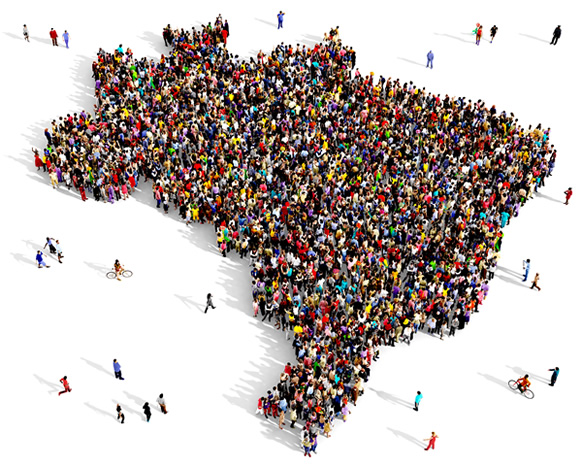
Gross Domestic Product (GDP)*
Total 2016: R$ 6.226 trillion;
GDP per capita (2016): R$ 30,407.
Per capita income (Rpc)*
Average in 2016: R$ 1,226;
Currency Exchange (US$ 1.00)*
Quotation on 12/30/14: R$ 2.66;
Quotation on 12/30/15: R$ 3.90;
Quotation on 12/30/16: R$ 3.26;
Quotation on 12/28/17: R$ 3.31.
*Sources: Brazilian Institute of Geography and Statistics (IBGE) and Central Bank of Brazil
Population Statistics
Census 2010 (inhabitants):
190,732,694
Projection in June/17 (inhabitants):
207,661,000
Five most populous states (inhabitants, projection July/2017):
1st: São Paulo (SP): 45,094,866
2nd: Minas Gerais (MG): 21,119,536
3rd: Rio de Janeiro (RJ): 16,718,956
4th: Bahia (BA): 15,344,447
5th: Rio Grande do Sul (RS): 11,322,895
Source: Brazilian Institute of Geography and Statistics (IBGE)
Why Brazilian Products?
Brazil has 7 natural biomes: Amazon, Caatinga, Campos do Sul, Cerrado, Atlantic Forest, Pantanal and Coastal (source: http://www.wwf.org.br). Such diversity translates into a large and rich variety of fruits, roots, herbs, spices, vegetables, extraction and cultivation, in small, medium and large scales. In line with global trends in demand for natural, sustainable, functional, organic and/or gourmet food, among other attributes, the Brazilian industry has been offering product lines with high quality and typical flavors, capable of enchanting palates in the various markets around the world.
12 CURIOSITIES ABOUT BRAZILIAN PRODUCTS
Be part of the project to visualize logistic points of interest around the world
Useful LinksContents of News and Services by the Federal Government.
siteInformation on Defense, Sovereignty and Armed Forces.
siteDocuments required for the stay, table of visas, entry and exit forms in the country.
siteUpdated information on epidemics and how to be protected.
siteLocation of the country‘s airports and the respective information/services available.
siteInformation on the Brazilian Financial System.
siteInformation on Geosciences, Social, Demographic and Economic Statistics.
siteInformation on Sea and River Harbours.
siteInformation on the Road, Railway and Waterway Infrastructures.
siteInformation on support for the production of goods and services to the external market (pre-shipment) and financing the marketing of these products abroad (post-shipment).
siteInformation on foreign trade credit lines.
siteIts institutional purpose is to promote the protection of the population‘s health.
site